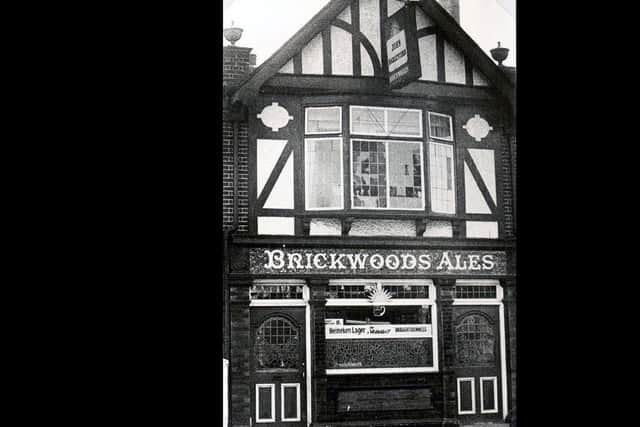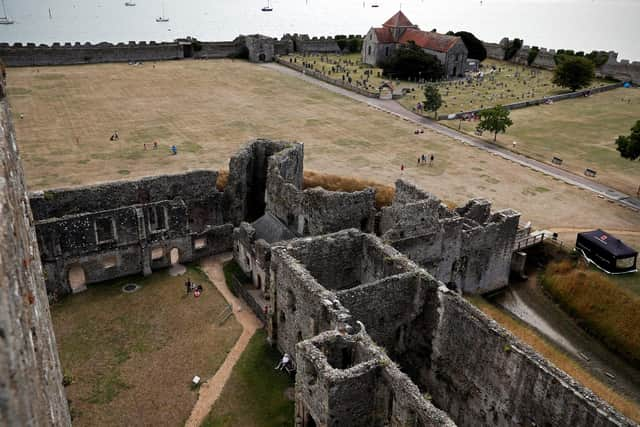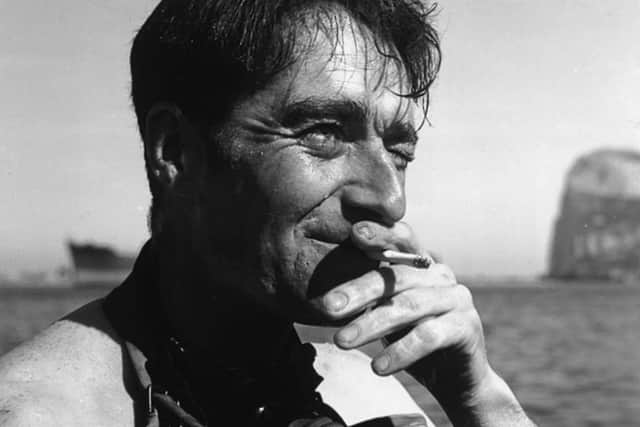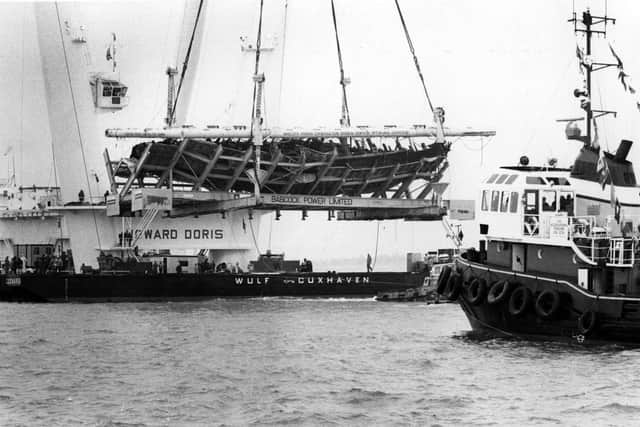6 of Portsmouth's most shocking unsolved mysteries
and live on Freeview channel 276
From historical legends to mysterious deaths and brutal murders, they continue to spark debates and conflicting reports.
Did Jack the Ripper pay a visit to our area? Could a UFO have been spotted flying above our ancestors heads? And what caused the Mary Rose to sink?
Advertisement
Hide AdAdvertisement
Hide AdAll of these tales and more are still waiting to be truly unraveled.


We have picked out six of Portsmouth’s the most shocking mysteries from through the years.
How many of these are you familiar with?
What happened to Buster Crabb?
Lionel ‘Buster’ Crabb’s disappearance in April 1956 has been regarded as one of the Portsmouth’s biggest conspiracy theories.


The Navy diver vanished after swimming under Soviet warships that were docked at Portsmouth Harbour during the Cold War.
Advertisement
Hide AdAdvertisement
Hide AdAfter he went missing, rumours swirled around that he was infiltrating Soviet ships for MI6.
Soviet Union Premiers Nikolai Bulganin and Nikita Khrushchev were on a goodwill visit to Britain to discuss the Suez canal dispute, as the Russians were supplying weapons to Egypt, but Krushchev accused the British of spying and halted the visit.
In an allegedly unrelated incident, Crabb was reported missing, and his headless body later washed up in Chichester harbour.


Some say he was caught and killed at the scene, while others say he died due to equipment failure or was captured by the USSR.
Advertisement
Hide AdAdvertisement
Hide AdEx-Russian soldier Eduard Koltsov claimed he slit Crabb’s throat after he placed a mine under one of the ships, but nothing was verified.
‘The Havant Tragedy’


Jack The Ripper is more than a household name and you probably think you know all about his victims, but there are some who believe the infamous killer had a stalking ground in Havant near Portsmouth.
In November 1888, the authorities received a letter with a Portsmouth postmark.
It read ‘it is no good for you to look for me in London because I am not there,' and was signed ‘Jack The Ripper.’
Advertisement
Hide AdAdvertisement
Hide AdA vicious and motiveless murder in Havant happened shortly afterwards.
A young boy, Percy Searle, was on an errand for his mum and was stabbed multiple times in the neck in the street while walking home.
Another child, Robert Husband, 11, witnessed the murder and claimed a ‘tall man’ was at the scene.
Robert himself was suspected by police – given his known animal cruelty and mimicking Jack The Ripper while playing with his friends – but was acquitted.
Advertisement
Hide AdAdvertisement
Hide AdSome have connected the letter to Percy’s death alongside superficial similarities to the Whitechapel murders, but others suspect Robert. We’ll never know.
The murder of Rose Robinson
The 63-year-old landlady of the now demolished John Barleycorn pub was savagely strangled to death.
This gruesome murder happened on Commercial Road in 1943, with the assailant killing Ms Robinson and stealing the pubs monthly takings – valued at £18,000 in todays money.
Career criminal Harold Loughans confessed to the robbery and murder in a flood of tears to the police.
Advertisement
Hide AdAdvertisement
Hide AdConsidering the fairly accurate statements and the fibres found on Mr Loughans’ shoes, similar to Ms Robinson’s rugs, the police thought they caught their man.
However, just before the trial, he claimed he was innocent, and after a compelling case from the defence – placing him in London – he was found as such.
The 47 year-old had previously given a previous false confession for a murder in Scotland, and did the same here.
He claimed it was a ‘hoax and a grand joke.’
Loughans’ ramblings didn’t end there, as he said he murdered Ms Robinson for the second time in the 1960s to a journalist at The People tabloid.
Advertisement
Hide AdAdvertisement
Hide AdHis links to the murder are highly sceptical, and the case remains unsolved.
Author Nick Fletcher, let us know about the Robinson murder. Murder Most Bizarre is published by Classic Books on October 1 priced £4.99 and is available from bookshops or direct from the author’s website www.nickfletcher.co.uk.
UFO sighting in the 1950s
The Ministry of Defence (MOD) investigated their first UFO sighting in 1950 in Portsmouth.
At RAF Tangmere, a pilot reported seeing a ‘circular, and bright metallic’ object roughly 1,000-2,000 feet above him.
Advertisement
Hide AdAdvertisement
Hide AdOther reports from four radar operators at RAF Wartling state an object was travelling at the same time as the pilots report.
It was flying at between 1350-1650 knots towards and away from the station.
As a response, the MOD created the ‘Flying Saucer Working Party’ to looking into UFO sightings.
In June 1951, a report from the group said there was no scientific proof of UFOs.
Advertisement
Hide AdAdvertisement
Hide AdWhile these sightings were brushed off as ‘optical illusions and psychological delusions’, many workers at the radar stations say the taskforce as there to deliberately supress these reports.
Does Portchester Castle pre-date the Romans?
Portchester Castle was originally a Roman fortification – Portus Adurni – but some suggest it has an extensive ancient past.
Before the Roman invasion, 43-48 AD, the settlement was supposedly called ‘Caer Peris’ and was linked to the legendary tales of Ferrex and Porrex.
Advertisement
Hide AdAdvertisement
Hide AdGeoffrey of Monmorth (1135–38) links the site and the brothers together in his book ‘History of the Kings of Britain, although his work is regarded as unreliable.
The mythical brothers quarrelled over their succession, with Porrex slaying his brother.
His mother was furious as Ferrex was her preferred son – and with an entourage – murdered Porrex and supposedly ‘cut him all in pieces.’
No other evidence links the tale and the name of ‘Caer Peris’ with Portchester Castle.
Advertisement
Hide AdAdvertisement
Hide AdThe fortification was built on an Ancient British settlement but the story behind the archaeology is unknown.
Matt Wingett let us know about Caer Peris, and his book – Mysteries of Portsmouth – is available on Amazon and in all good bookshops.
Why did the Mary Rose sink?
Henry VIII’s beloved warship famously sank during the battle of the Solent in 1545.
The colossal flagship fired at the French fleet and blew over while attempting to turn, according to an eyewitness.
Advertisement
Hide AdAdvertisement
Hide AdAs all the cannon holes were open, the 700 tonne ship filled with water and descended 40 feet to the ocean floor – most of the crew died.
The reason behind her destruction has baffled historians for decades, with multiple theories being bandied around.
Ferocious winds are usually blamed, but for many believe it was down to human error.
It was Admiral Sir George Carew’s first command, so his orders may have caused the ship to capsize.
Advertisement
Hide AdAdvertisement
Hide AdCarew’s cousin claimed the admiral said he crew members that he ‘could not rule’, but he was potentially trying to save face.
Other theories such as the ship being too overloaded with guns or being poorly designed are considered but remain unlikely.
A message from the Editor, Mark Waldron
You can subscribe here for unlimited access to our online coverage, including Pompey, for 27p a day.
Comment Guidelines
National World encourages reader discussion on our stories. User feedback, insights and back-and-forth exchanges add a rich layer of context to reporting. Please review our Community Guidelines before commenting.
